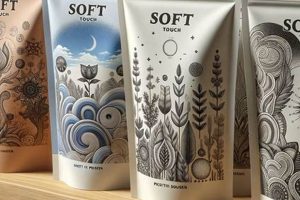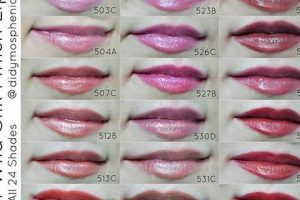Surface improvement processes utilizing specialized machinery and media offer a method for achieving refined material characteristics. This technique encompasses a range of applications from deburring and edge radiusing to polishing and surface preparation for subsequent treatments. For example, components used in the automotive industry may undergo this process to enhance durability and aesthetic appeal.
The significance of this approach lies in its ability to improve part quality, extend component lifespan, and ensure consistent results across large production volumes. Historically, these techniques have evolved from manual methods to highly automated systems, contributing to increased efficiency and reduced labor costs. This evolution has made it a critical step in various manufacturing sectors, improving both functional performance and cosmetic attributes.
The following sections will delve deeper into the specific methods employed, the types of equipment utilized, the various media options available, and the industries that benefit most from these controlled surface treatment solutions. A comprehensive understanding of these facets is essential for optimizing manufacturing processes and achieving desired outcomes.
Critical Considerations for Optimized Surface Treatment
Achieving optimal results in surface finishing requires careful attention to several key factors. The following guidelines outline essential considerations for maximizing efficiency and effectiveness.
Tip 1: Media Selection is Paramount. The choice of abrasive media directly impacts the final surface finish. Consider material compatibility, desired roughness, and part geometry when selecting media types, such as ceramic, plastic, or steel.
Tip 2: Process Parameter Control is Essential. Machine speed, cycle time, and compound concentration must be precisely controlled to ensure consistent and repeatable results. Deviations from established parameters can lead to unacceptable surface variations.
Tip 3: Part Fixturing and Orientation Matter. Proper fixturing minimizes part-on-part contact and ensures uniform exposure to the abrasive media. Inconsistent orientation can result in uneven surface treatment.
Tip 4: Compound Selection for Optimal Performance. The selected compound should complement the abrasive media and the material being processed. Consider factors such as lubricity, corrosion inhibition, and cleaning capabilities.
Tip 5: Regularly Monitor Media Condition. Abrasive media degrades over time and loses its effectiveness. Regular inspection and replacement of worn media are crucial for maintaining consistent performance.
Tip 6: Implement a Consistent Cleaning Protocol. Thoroughly cleaning parts before and after the surface finishing process prevents contamination and ensures optimal results. Residue from prior operations can impede surface treatment efficacy.
Tip 7: Conduct Regular Machine Maintenance. Routine maintenance of the equipment, including lubrication and inspection of critical components, is essential for preventing downtime and ensuring consistent performance.
Adhering to these guidelines will contribute to improved process control, reduced scrap rates, and enhanced overall product quality. Diligent application of these principles is fundamental to successful surface treatment operations.
The subsequent sections of this document will further expand on specific applications and advanced techniques in surface improvement.
1. Abrasive Media Selection
The selection of appropriate abrasive media is a foundational element in surface treatment. The efficacy of these operations is contingent upon the media’s ability to achieve the desired surface characteristics without compromising part integrity. Media selection is not arbitrary but requires a thorough understanding of the substrate material, geometric complexities, and required surface finish.
- Material Compatibility and Wear Rate
The media must be chemically compatible with the workpiece material to prevent adverse reactions or contamination. Its hardness should be sufficient to effect material removal but controlled to minimize excessive wear on the media itself. For instance, processing aluminum requires media that won’t introduce iron contamination, while steel components necessitate robust, fast-cutting abrasives. The wear rate of the media directly impacts process consistency and the need for media replenishment.
- Shape and Size Considerations
Media shape and size play a crucial role in accessing intricate part geometries. Smaller media can reach recessed areas and complex contours that larger media cannot. Different shapes, such as cones, pyramids, or spheres, offer varying levels of cutting action and surface contact. Selecting the appropriate shape and size minimizes part impingement and ensures uniform surface treatment across all exposed areas.
- Abrasive Composition and Density
The abrasive grains embedded within the media, such as aluminum oxide or silicon carbide, determine the cutting efficiency and surface roughness. Higher abrasive concentration typically results in faster material removal, while finer abrasive grains yield smoother surface finishes. The density of the media influences its settling rate within the process chamber, affecting the uniformity of treatment and potentially causing uneven wear patterns.
- Cost-Effectiveness and Media Lifespan
Although performance is paramount, cost-effectiveness is an important consideration. While some media may offer superior finishing capabilities, their higher cost and shorter lifespan might render them unsuitable for high-volume production. Evaluating the media’s lifespan, reusability, and potential for recycling contributes to a more sustainable and economically viable surface treatment process. This involves balancing initial investment with long-term operational costs.
The interplay between these factors demonstrates the complexity inherent in abrasive media selection. A comprehensive understanding of these considerations, coupled with empirical testing and process optimization, is essential for achieving consistent and predictable results in surface finishing. Accurate media selection significantly impacts both the aesthetic and functional attributes of the finished component.
2. Machine Parameter Optimization
Effective surface treatment relies heavily on machine parameter optimization. These settings directly influence the interaction between the workpiece, abrasive media, and chemical compounds, ultimately determining the final surface characteristics. Incorrect parameter settings can lead to inconsistent results, excessive material removal, or even damage to the components. The relationship is causative: parameter adjustments effect changes in the surface finishing outcomes. Machine parameter optimization constitutes a critical, integrated component of achieving the desired results during a surface refinement process. For instance, in vibratory finishing of aerospace turbine blades, precise control of the vibration frequency and amplitude is necessary to achieve specific edge radiuses without compromising airfoil integrity. If the frequency is too high, it can lead to excessive material removal, exceeding tolerance limits.
Further, consider the centrifugal disc finishing of small medical implants. Optimized machine parameters, such as disc speed and processing time, are essential for creating a smooth, biocompatible surface. If the disc speed is too low, the process may not adequately remove surface imperfections, potentially affecting the implant’s osseointegration. In practical applications, this understanding informs the development of standardized operating procedures and parameter ranges for specific materials and geometries. Machine parameter optimization is also integrated within automated systems that can adjust the finishing process using feedback from sensors and other data-acquisition methods.
In summary, optimized machine parameters are non-negotiable for achieving predictable and high-quality surface finishes. The correct selection and control of these parameters mitigate risks associated with inconsistent results or component damage. Future advancements will likely focus on adaptive control algorithms that respond dynamically to real-time process variations, further improving the precision and efficiency of surface treatment operations, and maintaining tolerances of finished surfaces.
3. Compound Chemical Composition
The chemical makeup of compounds used in surface treatment exerts a definitive influence on process outcomes. These compounds, often aqueous solutions containing detergents, corrosion inhibitors, and other specialized additives, directly impact the abrasive action, surface reactivity, and overall cleanliness of the treated parts. Selecting the appropriate compound is therefore integral to optimizing the surface finishing process. For instance, alkaline compounds are frequently employed in the treatment of aluminum to prevent oxidation and enhance the effectiveness of abrasive media, whereas acidic compounds may be used for descaling steel components. The compounds also provide lubrication, reducing friction between the parts and the abrasive media to prevent overheating and surface damage.
The interaction between the compound and the workpiece material directly affects the rate of material removal and the final surface finish. Compounds containing chelating agents can dissolve surface contaminants and enhance the cleaning action. Corrosion inhibitors protect the treated components from oxidation and rust, extending their lifespan. In vibratory finishing, incorrect compound selection can lead to staining, pitting, or inadequate surface refinement, thereby undermining the entire process. Therefore, careful consideration of the chemical compatibility between the compound and the workpiece material is paramount to avoid adverse effects and ensure the desired results. The nature of chemical interactions at the surface influences the process.
In summation, the chemical composition of surface treatment compounds represents a pivotal aspect of surface refinement. The selection of the correct formulation ensures optimal cleaning, corrosion protection, and surface finishing, contributing to enhanced part quality and process efficiency. Challenges remain in developing environmentally friendly compounds that maintain efficacy and minimize waste disposal costs. The interplay of the compounds and abrasives with the target materials, is central to successful surface finish outcomes.
4. Part Fixture Design
Part fixture design plays a critical role in achieving consistent and predictable results during surface treatment operations. These fixtures, typically custom-engineered for specific component geometries, dictate part orientation and exposure within the processing chamber. Improper fixture design can lead to uneven surface treatment, increased part-on-part contact, and compromised dimensional tolerances. The relationship is deterministic: fixture characteristics directly affect the forces and media distribution exerted upon the components. For instance, if small, complex parts are bulk processed without proper fixturing, they may cluster together, shielding certain areas from the abrasive action, and resulting in non-uniform surface finishes. Accurate fixture designs are integral components of surface refinement processes.
In practical applications, custom fixtures are designed to optimize part positioning within the vibratory finishing bowl or centrifugal disc machine. For instance, when deburring turbine blades, dedicated fixtures hold each blade individually, ensuring uniform exposure to the media and preventing damage from inter-part collisions. Similarly, for medical implants requiring highly polished surfaces, specialized fixtures are employed to maintain precise orientation and prevent surface scratching. These fixtures are often manufactured from chemically resistant materials to withstand the corrosive effects of the process compounds. Furthermore, the design must consider the loading and unloading process, ensuring efficiency and minimizing manual handling of the components. The fixtures contribute to streamlined workflow and consistent part processing.
In conclusion, part fixture design represents a critical element in achieving consistent and predictable surface treatment outcomes. Thoughtful consideration of part geometry, process dynamics, and material compatibility is essential for creating effective fixtures that optimize surface finishing and ensure the integrity of the processed components. Future innovations will likely focus on modular fixture systems and additive manufacturing techniques to facilitate rapid prototyping and customization for diverse part geometries. The importance of part fixture design is evident: precise fixtures contribute to highly refined surface finishes.
5. Process Cycle Duration
Process cycle duration, representing the time a component remains within a surface treatment system, constitutes a pivotal determinant of outcome quality. Within surface improvement processes, cycle duration directly influences the extent of material removal, surface refinement, and overall consistency. Inadequate or excessive cycle times undermine process efficacy.
- Material Removal Rate
Cycle duration governs the degree of material removal during deburring, edge radiusing, and surface polishing. Shorter durations may prove insufficient for achieving desired material removal, leaving burrs or sharp edges. Conversely, prolonged exposure can result in excessive material loss, compromising dimensional tolerances. The required duration is thus contingent on the material properties, initial surface condition, and abrasive media characteristics. For example, the deburring of aluminum castings often requires shorter cycle durations than that of hardened steel components due to aluminum’s lower hardness.
- Surface Finish Quality
The smoothness and uniformity of the surface finish are intrinsically linked to process cycle duration. A longer duration allows for more extensive surface abrasion, potentially yielding smoother finishes. However, extended durations can also introduce surface irregularities or waviness, particularly if the abrasive media becomes contaminated or worn. The optimal cycle duration must therefore balance the need for surface smoothness with the risk of introducing unwanted surface defects. Polishing of stainless steel components in pharmaceutical applications often necessitates precisely controlled cycle durations to achieve specified surface roughness values (Ra) without compromising surface integrity.
- Process Consistency and Repeatability
Maintaining consistent cycle durations is essential for ensuring process repeatability across production batches. Variations in cycle time can introduce inconsistencies in material removal and surface finish, leading to quality control issues. Standardized operating procedures and automated control systems are often employed to minimize cycle time variations and ensure uniformity. The consistency of process cycle duration leads to a consistent rosler finishing.
- Economic Efficiency and Throughput
Process cycle duration directly impacts the economic efficiency and throughput of surface treatment operations. Shorter cycle times increase production throughput, reducing per-part costs. However, excessively short cycles may compromise quality, necessitating rework or scrap. Determining the optimal cycle duration requires balancing throughput considerations with quality requirements. The efficient implementation of process cycle duration can maximize the output of rosler finishing.
In conclusion, process cycle duration is a multifaceted parameter that significantly affects the outcome of surface treatment operations. Precise control and optimization of cycle duration are essential for achieving desired surface characteristics, ensuring process consistency, and maximizing economic efficiency. The facets described contribute to a deeper understanding of how the duration of these processes effects material properties.
6. Maintenance Schedule Adherence
Strict adherence to a pre-defined maintenance schedule is paramount to preserving the operational integrity and performance consistency of surface treatment equipment. A proactive maintenance program mitigates the risks of unscheduled downtime, ensures optimal process parameters, and safeguards component quality. Neglecting scheduled maintenance can lead to equipment malfunctions, process inconsistencies, and increased operational costs, directly impacting the efficacy of surface treatments.
- Equipment Uptime and Availability
Regular maintenance, including lubrication, filter replacement, and component inspection, minimizes the likelihood of equipment failure and extends the operational lifespan. Consistent adherence to a maintenance schedule guarantees that the machine operates at optimal settings, preventing unexpected stoppages that disrupt production flow. A poorly maintained vibratory finishing machine, for example, may experience bearing failure, halting production until repairs are completed. Increased uptime directly translates to higher productivity and reduced per-part costs.
- Process Parameter Stability
Scheduled maintenance ensures that critical process parameters, such as vibration frequency, media flow rate, and compound concentration, remain within specified tolerances. Deviations from these parameters can lead to inconsistent surface finishes and compromised component quality. Calibrating sensors and control systems as part of routine maintenance guarantees accurate monitoring and control of the surface treatment process. Insufficient compound levels, due to malfunctioning dispensing systems, for example, will produce inconsistent surface finishing. Consistent process parameters are crucial for repeatable and predictable outcomes.
- Component Wear and Replacement
A proactive maintenance schedule includes the inspection and timely replacement of worn components, such as belts, bearings, and seals. Addressing wear issues before they escalate prevents catastrophic failures and minimizes downtime. Regular inspections can detect signs of premature wear, allowing for proactive repairs and preventing secondary damage to other equipment components. Failing to replace worn media screens, for instance, causes poor media separation, and reduced surface finishing effectiveness. Maintaining component integrity guarantees consistent machine performance and reduces the risk of costly repairs.
- Safety and Regulatory Compliance
Adherence to a maintenance schedule guarantees that safety features, such as emergency stop mechanisms, safety guards, and ventilation systems, function correctly and meet regulatory requirements. Regular inspections and testing of these safety features protect personnel from injury and prevent environmental hazards. Neglecting safety-related maintenance can result in accidents, fines, and legal liabilities. For example, proper maintenance of ventilation systems is critical for removing hazardous fumes and dust particles generated during surface treatment, ensuring a safe working environment. Prioritizing safety measures protects personnel and ensures compliance with safety standards.
The integration of these facets highlights the irrefutable link between maintenance schedule adherence and the consistent delivery of high-quality surface treatments. Regular inspections and repairs not only protect the integrity of processing equipment, but more importantly, optimize component quality and safety standards. Proactive maintenance facilitates sustained operational efficiency and superior surface finishing outcomes across the board.
Frequently Asked Questions Regarding Surface Treatment Processes
This section addresses common inquiries pertaining to specialized surface treatment processes, aiming to provide clarity and promote a deeper understanding of associated methodologies.
Question 1: What distinguishes vibratory finishing from centrifugal disc finishing?
Vibratory finishing employs a vibrating bowl or tub to induce relative motion between parts and media, suitable for a wide range of part sizes and geometries. Centrifugal disc finishing, conversely, utilizes a rotating disc to generate higher forces and more aggressive material removal, particularly effective for smaller components requiring rapid processing.
Question 2: How does abrasive media selection impact the final surface finish?
The choice of abrasive media significantly influences the surface roughness, material removal rate, and overall aesthetic appearance of treated parts. Media composition, shape, and size must be carefully considered to achieve the desired surface characteristics without compromising dimensional tolerances.
Question 3: What role do chemical compounds play in surface finishing operations?
Chemical compounds, typically aqueous solutions, serve multiple functions, including cleaning, lubrication, corrosion inhibition, and pH control. The specific composition of the compound influences the rate of material removal, surface reactivity, and overall cleanliness of the processed components.
Question 4: How does process cycle duration affect the outcome of surface treatment?
Process cycle duration dictates the extent of material removal, surface refinement, and overall process consistency. Inadequate cycle times may result in incomplete deburring or polishing, whereas excessive durations can lead to over-processing or dimensional inaccuracies. Optimal cycle times depend on material properties, part geometry, and process parameters.
Question 5: What are the key considerations in designing part fixtures for surface finishing?
Part fixture design must account for component geometry, material properties, and process dynamics. Effective fixtures ensure uniform part exposure, minimize part-on-part contact, and maintain dimensional stability throughout the surface treatment operation.
Question 6: Why is regular maintenance of surface treatment equipment essential?
Consistent adherence to a maintenance schedule minimizes the risk of equipment failure, ensures stable process parameters, and preserves component quality. Proactive maintenance includes lubrication, filter replacement, component inspection, and calibration of control systems. Neglecting maintenance can lead to increased downtime, process inconsistencies, and higher operational costs.
In summary, informed decision-making regarding process parameters, media selection, and maintenance practices is critical for achieving consistent and predictable outcomes in surface treatment operations. Understanding the interplay between these elements promotes optimal process control and enhanced component quality.
The subsequent section will explore emerging trends and future directions in the field of controlled surface treatment solutions.
Rosler Finishing
The preceding exploration has illuminated key aspects of surface improvement. Examination of media selection, parameter optimization, chemical compound influence, fixture design, cycle duration, and maintenance schedules underscores the multifaceted nature of achieving consistent and repeatable results. These factors, when meticulously managed, contribute to enhanced component performance and extended operational lifespan, and optimized surfaces.
The information presented serves as a foundation for informed decision-making and process refinement. Continued advancements in equipment, media, and methodologies will undoubtedly further enhance the capabilities and efficiency of these critical manufacturing processes. Strategic application of these concepts remains essential for sustained competitive advantage and the delivery of high-quality, reliable components.







